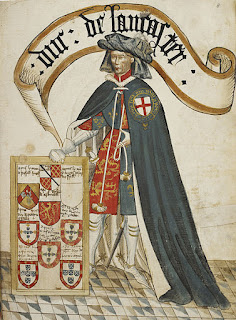Regarding the medical metaphors: we don't know that Grosmont himself had a large library, but his writing suggests a well-read man who could draw on other sources for his knowledge and ideas. Also, he would have had access to Leicester Abbey's library near his home, which at the time held at least 80 books on medicine. He also—as many nobles would— had a personal physician from Bologna from whom he would have learned much. (Bologna was known for training physicians, such as Jacob Mantino and Guy de Chauliac.)
His own physician probably gave him the information mentioned here that theriac is a good poison for driving out other poisons; however, if the patient is too far gone because of poison, theriac will only make things worse. He also offers the cure for delirium by slicing open a live young rooster and placing the cockerel on the patient's head.
During Grosmont's lifetime, Pope Urban V (whose personal physician was Guy de Chauliac) founded the medical University of Montpelier. One of its features was the collection of the bodies of executed criminals for dissection and research. Grosmont wishes his own soul could be opened up in this way to examine and understand his sin.
Some less medical or religious comments are about things like salmon. They understood that salmon are born in freshwater streams then head out to the ocean only to return to their streams to spawn. He expresses that a salmon born in a stream is not truly a salmon because it has not gone through its life cycle of stream-ocean-stream. He also tells us that goat's milk is ideally drunk in Spring, because the goat has only dined on new fresh plants at that time. Grosmont also offers a recipe for chicken soup, and how to know if a pomegranate is fresh.
In 1360, Grosmont was chief negotiator of the Treaty of Brétigny, ending a phase of the Hundred Years War. When he returned to England from the continent late in that year, he fell ill. Although only about 50 years old, he died on 23 March 1361. There was a resurgence of the Bubonic Plague that year, but it was not being noted until May, so we cannot attribute his death to it. He also wrote up a will 10 days before his death, so whatever prompted him to do so took longer to kill him than the Plague would. He was buried in the Church of the Annunciation of Our Lady of the Newarke ("New Work") in Leicester, which Grosmont had founded in 1354.
I am thinking that paragraph three above mentions something that would be unfamiliar to most readers. Tomorrow I'll explain theriac. See you then.

.jpg)












